Marieta Akalski - Is She Canada's Best Female Climber?
After six years away from climbing, 32 year-old Marieta Akalski has come roaring back with one of the most impressive female tick lists in Canadian climbing history.
We caught up with her when she got back to Toronto.
We caught up with her when she got back to Toronto.
You have a somewhat interesting family history when it comes to climbing. Care to share?
Marieta: I’ve been pretty fortunate to have a family that owns the Toronto Climbing Academy, one of the gyms in the city. This allowed me to start climbing at the age of 12, and let's just say I lived at the gym. My dad who has an education in sports training and exercise naturally became my coach during my early years.
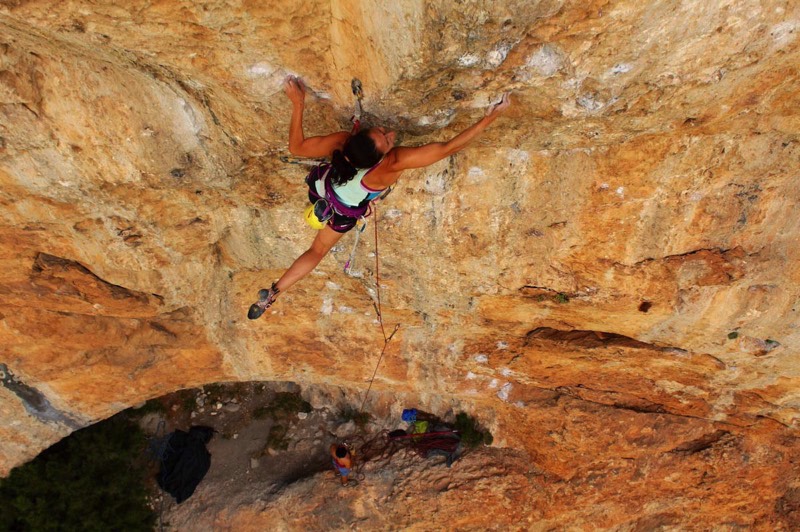
Marieta Akalski on Les Chacals 5.13d. Photo courtesy of Michael Watson.
You started climbing and competing at an early age and then sort of dropped out of the scene. What happened?
Marieta: I definitely trained really hard as a youth and had my fair share of burn-outs. I needed to take months off at a time from climbing during my teens and early 20s.
What led to my six year break from climbing was growing up and starting a career. I had finished business school and started a career in finance where I worked 12-hour days and studied for the Chartered Financial Analyst (CFA) designation during my time off. Let’s just say, time for climbing just didn’t exist.
After four years, I realized I couldn’t sustain this lifestyle and I decided to quit finance and go back to school to become a Registered Massage Therapist (RMT). This new career path gave me the opportunity to get back into climbing which I had missed so much by this point.
What led to my six year break from climbing was growing up and starting a career. I had finished business school and started a career in finance where I worked 12-hour days and studied for the Chartered Financial Analyst (CFA) designation during my time off. Let’s just say, time for climbing just didn’t exist.
After four years, I realized I couldn’t sustain this lifestyle and I decided to quit finance and go back to school to become a Registered Massage Therapist (RMT). This new career path gave me the opportunity to get back into climbing which I had missed so much by this point.
On this last trip you managed to bag a number of 14s rather quickly – a new standard for you. Care to list some of recent hard sends and explain how you transitioned to this new level of difficulty?
Marieta:
5.14b Florida – Rodellar, Spain
5.14a Geminis – Rodellar, Spain
5.14a Ixeia – Rodellar, Spain
5.13d Gladiator – Rodellar, Spain
5.13d Les Chacals – Rodellar, Spain
5.13d Esprit Rebelled – Rodellar, Spain
5.13d Tomb Raider – Rifle, Colorado
5.13c Spray-A-Thon – Rifle, Colorado
5.13c Apocalypse – Rifle, Colorado
5.13c Cryptic Egyptian – Rifle, Colorado
5.13c The Path – Rifle, Colorado
I believe there are several factors that allowed me to achieve these new levels in my climbing.
First, I sacrificed everything in Toronto (home, clients, relationships) in order to get on the road for a few months. Although I sent each climb relatively quickly, having several weeks in a new place took the pressure off. It let me start from the bottom and work my way up. Every climbing destination is different and you need time to adapt to the climbing style, recover from jet lag, deal with unexpected weather conditions, meet trustworthy partners, and for me personally, get used to the longer distances between bolts. I’ve been to walls that I was too intimidated to climb on initially, but I eventually overcame my fears.
Second, I believe in a pyramid structure when it comes to moving up the grade ladder. I think it’s important to do several climbs at each grade in order to build your base and your confidence before you move to the next grade. Many climbers tend to pick a project before even seeing it - they get fixated on the project grade. Instead, they should be climbing easier routes to build their confidence, experience and motivation. This approach better prepares you to eventually send your harder projects. I started by projecting 13a at the beginning of the trip since that was my hardest send since my return.
Finally, all I’ve focused on since I got back to climbing three years ago is bouldering and training. My power was at its peak before I left on my trip. This may not be the case for everyone, but if I can do all the moves, I know can send the climb. So ultimately my power is what holds me back from climbing harder. Endurance comes more naturally to me, and endurance is more than 50 percent mental.
5.14b Florida – Rodellar, Spain
5.14a Geminis – Rodellar, Spain
5.14a Ixeia – Rodellar, Spain
5.13d Gladiator – Rodellar, Spain
5.13d Les Chacals – Rodellar, Spain
5.13d Esprit Rebelled – Rodellar, Spain
5.13d Tomb Raider – Rifle, Colorado
5.13c Spray-A-Thon – Rifle, Colorado
5.13c Apocalypse – Rifle, Colorado
5.13c Cryptic Egyptian – Rifle, Colorado
5.13c The Path – Rifle, Colorado
I believe there are several factors that allowed me to achieve these new levels in my climbing.
First, I sacrificed everything in Toronto (home, clients, relationships) in order to get on the road for a few months. Although I sent each climb relatively quickly, having several weeks in a new place took the pressure off. It let me start from the bottom and work my way up. Every climbing destination is different and you need time to adapt to the climbing style, recover from jet lag, deal with unexpected weather conditions, meet trustworthy partners, and for me personally, get used to the longer distances between bolts. I’ve been to walls that I was too intimidated to climb on initially, but I eventually overcame my fears.
Second, I believe in a pyramid structure when it comes to moving up the grade ladder. I think it’s important to do several climbs at each grade in order to build your base and your confidence before you move to the next grade. Many climbers tend to pick a project before even seeing it - they get fixated on the project grade. Instead, they should be climbing easier routes to build their confidence, experience and motivation. This approach better prepares you to eventually send your harder projects. I started by projecting 13a at the beginning of the trip since that was my hardest send since my return.
Finally, all I’ve focused on since I got back to climbing three years ago is bouldering and training. My power was at its peak before I left on my trip. This may not be the case for everyone, but if I can do all the moves, I know can send the climb. So ultimately my power is what holds me back from climbing harder. Endurance comes more naturally to me, and endurance is more than 50 percent mental.
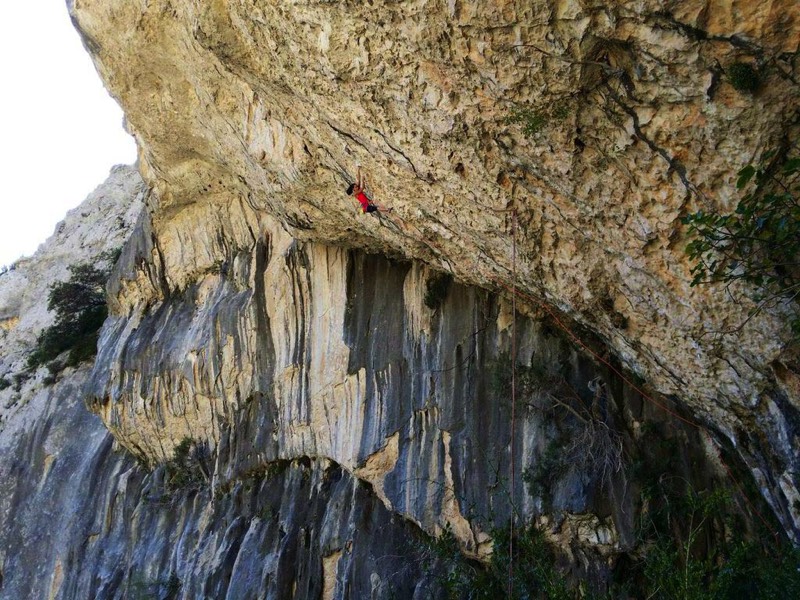
Marieta Akalski on Florida 5.14b
What was your hardest redpoint prior to this trip?
Marieta: I did one 5.13c in Potrero Chico, Mexico about 10 years ago.
I’ve stated publicly that you’re currently climbing better than any Canadian woman (and many men) at the moment. To find another woman that has performed at a similar level (for the time) you'd have to go all the way back to the 90s with Jola Sandford. Why do you think there has been such a massive vacuum at the upper tier of Canadian female sport climbing (with perhaps the exception of Ellen Powick who has been living in Salt Lake City for about the last decade)?
Marieta: I can’t speak too much about Western Canada but for the eastern end of the country I think our biggest obstacles are weather, access, opportunity and time. Certainly we have local crags, some closer and with easier access than others, but it’s not even comparable to many of the European areas where you can drive one or two hours and hit up several crags with numerous hard climbs at each grade. Once you reach a certain level in climbing I think Canada becomes very limited in the number of hard routes it offers. If you want to be challenged locally you will likely fixate on one climb because you only have a handful of routes at the upper grades.
That means if you want to push your limit, you need to travel. Climbing trips generally require a fair amount of financial resources and time. Most of the Canadian women pushing the boundaries the last few years have all done it on the road taking several months to travel with the intention of just climbing.
Not everyone has the opportunity to take this much time off from their careers in order to climb at world class destinations. I can name many Canadian women who would be able to reach these levels if they had the opportunity to hit the road and access hundreds of difficult lines within a small area.
That means if you want to push your limit, you need to travel. Climbing trips generally require a fair amount of financial resources and time. Most of the Canadian women pushing the boundaries the last few years have all done it on the road taking several months to travel with the intention of just climbing.
Not everyone has the opportunity to take this much time off from their careers in order to climb at world class destinations. I can name many Canadian women who would be able to reach these levels if they had the opportunity to hit the road and access hundreds of difficult lines within a small area.
As a climber, what do you think are some of the biggest benefits of living in Toronto?
Marieta: Are there any? I’m going to be really frank with this one. Personally, the only benefit I can see is the access to so many awesome climbing gyms. On the non-climbing front, I like being back with my friends and family and going out for dinner and drinks.
And some of the biggest drawbacks?
Marieta: Proximity to climbing crags, lack of selection for hard routes, lack of diversity in climbing style at the local crags and climate.
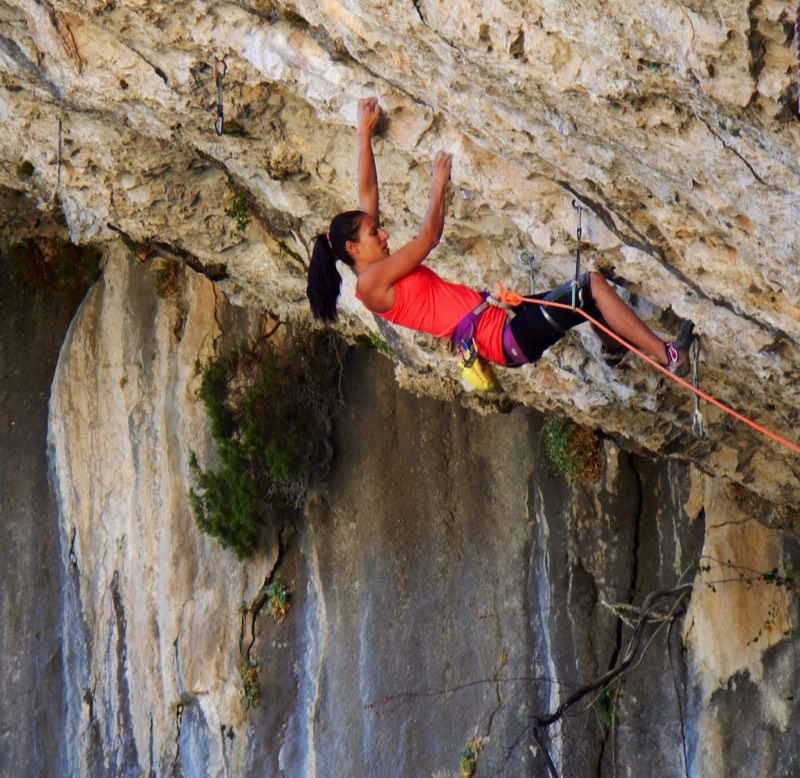
Marieta Akalski on Florida 5.14b
How are you paying the bills and why did you choose that career?
Marieta: Massage Therapy. When I’m in the city and working, it’s great. I love what I do and I love making people feel better. It’s very rewarding to see my clients improve. I wanted a flexible career that I could do anywhere and could also easily take time off to go climbing.
I’m very fortunate to work at Athlete’s Care, a sports medicine clinic that's supportive of my climbing endeavours; I'm able to come back to a job after being away. I’m also grateful for my loyal clients who understand my absences.
I’m very fortunate to work at Athlete’s Care, a sports medicine clinic that's supportive of my climbing endeavours; I'm able to come back to a job after being away. I’m also grateful for my loyal clients who understand my absences.
You are seeing a lot more girls and boys getting into competitive climbing at a very early age. As someone who went through a similar path, do you think this is a good or bad thing?
Marieta: It’s amazing to see all the young guns out competing. What sets this generation apart is the opportunity for many of these kids to be a part of an organized team. Working with a coach and as part of a team provides support and prevents burn out. These kids are the future of climbing.
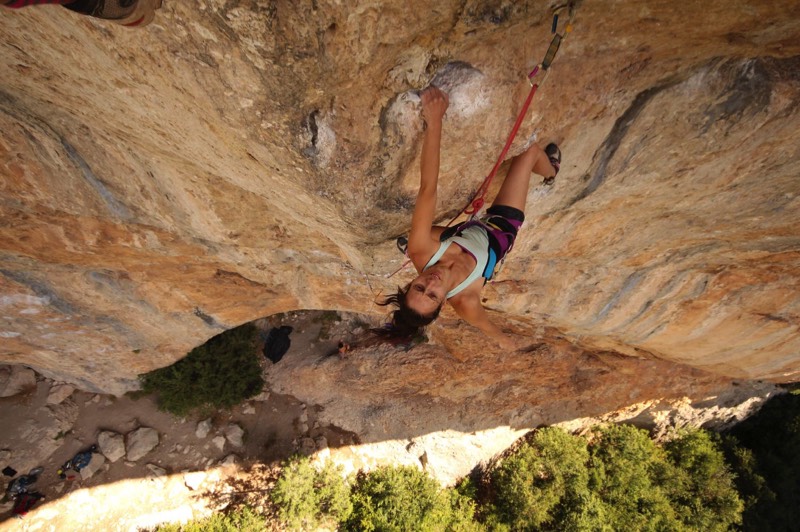
Marieta Akalski on Les Chacals 5.13d. Photo courtesy of Michael Watson.
Folks want to know your training secrets. Got anything you’re willing to share?
Marieta: I have no secrets because I don't have a proper training routine.
Honestly, I went through a rough stage last year. After such a long break, I thought my tendons and muscles were ready to take on training, but I was sadly mistaken. It was a rough year with injury after injury.
I had this goal of following a proper training routine with several cycles, but by the time I healed, it was already the start of the comp season. So I switched gears and just focused on training my weaknesses so that I would become a better climber, but not necessarily a better competition boulderer.
Power has always been my weakness, so I focused most of my time on that. I incorporated weight training, campusing and hang boards into my training. I also learned to listen to my body and rest properly.
Honestly, I went through a rough stage last year. After such a long break, I thought my tendons and muscles were ready to take on training, but I was sadly mistaken. It was a rough year with injury after injury.
I had this goal of following a proper training routine with several cycles, but by the time I healed, it was already the start of the comp season. So I switched gears and just focused on training my weaknesses so that I would become a better climber, but not necessarily a better competition boulderer.
Power has always been my weakness, so I focused most of my time on that. I incorporated weight training, campusing and hang boards into my training. I also learned to listen to my body and rest properly.
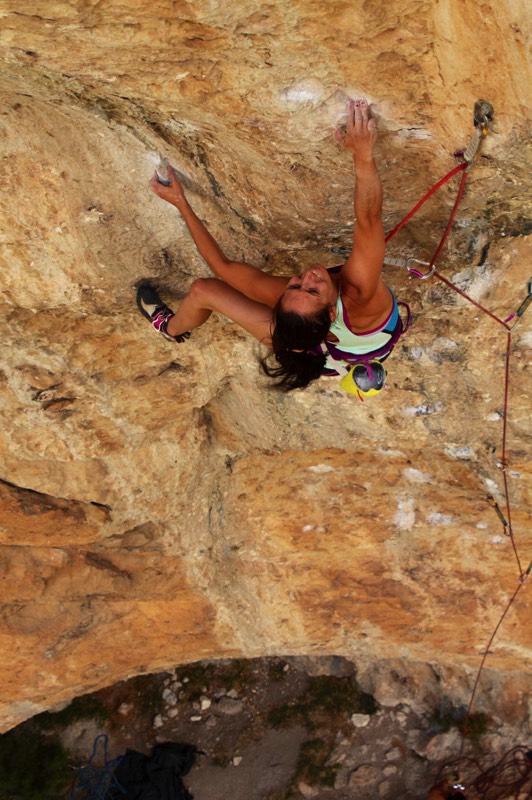
Marieta Akalski on Les Chacals 5.13d. Photo courtesy of Michael Watson.
How about some specific advice for women who want to climb harder?
Marieta: I think sometimes women are afraid to step out of their comfort zones in order to achieve their climbing goals. You need to take falls and get comfortable falling. If you can’t find a travel partner, then consider hitting the road on your own. You have to expose yourself to as many climbs at your level or harder and then try to climb them. And even if you don't repoint every route, you'll learn something that you can apply to future climbs.
A major component that's not discussed enough in climbing is your mental capabilities. You need to believe and see yourself doing what you want to achieve. Everybody goes through ups-and-downs with motivation and frustration. Knowing how to deal with these stresses is an important skill.
A major component that's not discussed enough in climbing is your mental capabilities. You need to believe and see yourself doing what you want to achieve. Everybody goes through ups-and-downs with motivation and frustration. Knowing how to deal with these stresses is an important skill.
Next road trip – where, when and why?
Marieta: I would love to find a way to get back to Spain for February 2015 and climb in Oliana and Margalef - two of Spain’s best climbing destinations for hard routes.
What about future climbing and non-climbing goals?
Marieta: I dream big but I’m also a realist. If I can find a way to work in Spain, then my goals would be to send even harder routes. I stood underneath one of Margalef’s most inspiring lines this fall, Era Vella 9a (5.14d). Maybe that will be first 9a, but first I need to do an 8c+ (5.14c).
Otherwise, I’ll keep traveling for shorter periods and keep working in Toronto.
Otherwise, I’ll keep traveling for shorter periods and keep working in Toronto.


